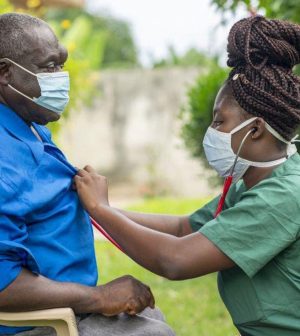- Navigating Your Midlife Crisis: Embracing New Possibilities
- City Raccoons Showing Signs of Domestication
- Mapping the Exposome: Science Broadens Focus to Environmental Disease Triggers
- One Week Less on Social Media Linked to Better Mental Health
- Your Brain Changes in Stages as You Age, Study Finds
- Some Suicide Victims Show No Typical Warning Signs, Study Finds
- ByHeart Formula Faces Lawsuits After Babies Sickened With Botulism
- Switch to Vegan Diet Could Cut Your Greenhouse Gas Emissions in Half
- Regular Bedtime Does Wonders for Blood Pressure
- Dining Alone Could Mean Worse Nutrition for Seniors
Nursing Home Staff Closest to Patients Are Least Likely to Get COVID Vaccines

Aides in long-term care facilities are less likely than other staff to be vaccinated, even though they have the most contact with vulnerable patients and could infect them with COVID-19, a new federal study shows.
Researchers from the U.S. Centers for Disease Control and Prevention analyzed data from 300 long-term care facilities nationwide. The research showed that 75% of physicians working at the facilities had been vaccinated by March of this year, compared with just 46% of the aides who worked every day with residents, CNN reported.
“One concern is that nurses and aides in this sample, who have the most patient contact, had the lowest vaccination coverage. COVID-19 outbreaks have occurred in long term care facilities in which residents were highly vaccinated, but transmission occurred through unvaccinated staff members,” Dr. James Lee, CDC Covid-19 Response Team, and colleagues wrote.
They added that their study “also has equity implications: national data indicated that aides in nursing homes are disproportionately women and members of racial and ethnic minority groups, with median hourly wages of $13–$15 per hour; aides are also more likely to have underlying conditions that put them at risk for adverse outcomes from COVID-19,” CNN reported.
“As vaccination was made available on site and lower vaccination rates reflected higher declination rates, vaccine hesitancy might have been an important contributor to under-vaccination in these facilities,” according to the study published July 30 in the CDC’s Morbidity and Mortality Weekly Report.
“Among aides, lower vaccination coverage was observed in those facilities located in more socially vulnerable zip code areas. Together, these data suggest that vaccination disparities among job categories likely mirror social disparities in general as well as disparities in the surrounding communities,” they added.
“Vaccination promotion and outreach efforts focused on socially vulnerable and marginalized groups and communities could help address inequities,” the researchers said.
While more aides may have been vaccinated since March, long-term care facilities have high staff turnover rates, the authors noted.
Flu shot campaigns have demonstrated that vaccine requirements may be the best way to get the largest number of employees vaccinated, according to the researchers.
More information
Visit the Agency for Healthcare Research and Quality for more on nursing home safety.
SOURCE: CNN
Source: HealthDay
Copyright © 2025 HealthDay. All rights reserved.










